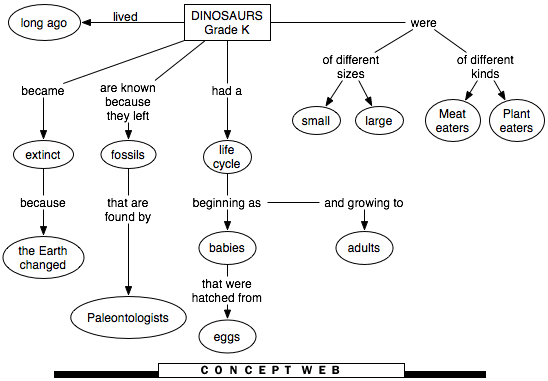|
|
 |
Dinosaurs - Lesson Overview
On this page
- Prior Knowledge
- Mathematics, Science, and Language Objectives
- Vocabulary
- Concept Web
The student has
- counted from one to 10
- measured using string or ruler
- sorted and sequenced by size
- participated in whole group discussion/activities
- become familiar with conventional print.
Mathematics
The student will
- classify objects on the basis of one variable and summarize information on
a graph
- sequence sets of objects from smallest to largest and vice versa
- count from one to as many as she/he can
- measure objects using non-standard units
- arrange pictures to show the relative size of a human, a two-story house,
and a dinosaur
- associate a numeral with "how many" in a given set including zero
- use geometric shapes to form new shapes
- explore concepts of time
- explore addition and subtraction using counters.
Science
The student will
- say that fossils are evidence that dinosaurs, and other plant and animal
life, existed on earth many years ago, even though we cannot see them today
- list at least three conditions that will cause a species to become
extinct
- describe dinosaurs as giant lizards and classify them as either plant
eaters or meat eaters
- say that dinosaurs hatched from eggs and had a life cycle
- draw, in sequence, the life cycle of a dinosaur and of a reptile
- say that dinosaurs' bones and other objects (fossils) are found buried in
the earth
- list at least three characteristics of a reptile
- list dinosaur weapons and describe how dinosaurs defended themselves
- describe how nature changes in at least two ways and at least two ways in
which nature remains the same.
Language
The student will
- acquire English sounds and intonation patterns
- develop and share ideas by engaging in conversation
- participate in role playing and choral speaking
- develop and use appropriate, relevant vocabulary
- demonstrate emerging writing by keeping a journal
- make inferences by predicting story outcomes
- demonstrate independent writing and dictation.
dinosaur
dinosaurio |
claws
garras |
horn
cuerno |
armour
blindaje |
beak
pico |
extinct
extinto |
evidence
evidencia |
life cycle
ciclo de vida |
diplodocus
diplodoco |
brontosaurus
brontosaurio |
tyrannosaurus
tiranosaurio |
specie
especie |
fossil
fósil |
theory
teoría |
carnivore
carnívoro |
erupt
hacer erupción |
footprint
huella |
herbivore
hervívoro |
iguanodon
iguanodón |
large
grande |
order
poner en orden |
paleontologist
paleontólogo |
palm tree
palma |
pteranodon
pteranodón
(technically a reptile and not a dinosaur) |
reptile
reptíl |
sequence
poner en suscención |
skeleton
esqueleto |
small
pequeño |
stegosaurus
estegosauruo |
triceratops
(triceratops) |
volcano
volcán |
baby dinosaur
dinosaurito or dinosauricillo |
long ago
hace mucho tiempo, en tiempo pasado |

|
|

